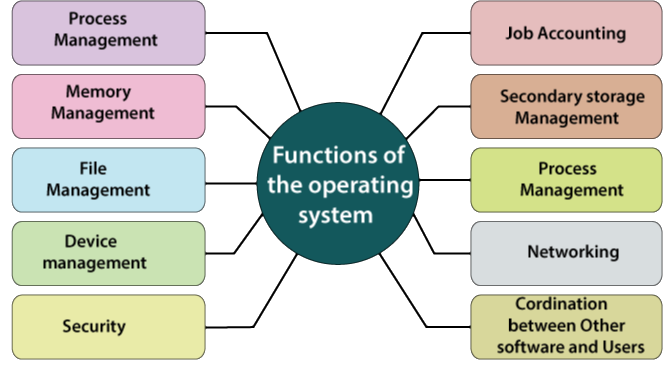Functions of Operating System
The functions of Operating System are:
- Process Management
- Memory Management
- File Management
- Device Management
- Secondary storage Management
- Security
- Coordination between other software and users
- Networking
- Job Accounting
- Error detecting aids

1. Process Management
Process Management support operating system to create and delete processes. Process management also offers a mechanism for synchronization and communication among processes.
An operating system performs the following activities for process management:
- The operating system maintains the track of the processor and the status of a process. The software which performs this task is referred to as a traffic controller.
- It assigns the processor to the process.
- It also performs the task of the de-allocated processor, if a process is no longer needed for the processor.
2. Memory Management
Memory Management is used to manage Primary memory as well as secondary memory. The memory management module performs the allocation job and de-allocation of memory to the program.
The operating system performs various activities for memory management are:
- It keeps track of memory means which part of the memory is in use, and what part of the memory is not in use.
- Operating system helps to allocate the memory at the time when the process request for memory.
- If process no longer needs memory, then de-allocates the memory.
- In multiprogramming, the task of memory allocation to the processes is done with the help of Operating System.
3. File Management
For fast or simple navigation and easy usage file system is organized into directories. These directories consist of directories and other files. It helps to handle all the file-related tasks like organization storage, retrieval, sharing, naming and files protection. It preserves track of information, location, status, user, etc.
4. Device Management
Operating System performs the task of allocations and de-allocations of the devices. It helps to keeps the track of all the devices. With the help of Operating system, device communication via their respective drivers is performed. It manages the device in an effective manner.
5. Secondary Storage Management
Operating System is responsible for secondary storage management. The System has various levels of storage that consist of primary storage, secondary storage, and cache storage. The set of instruction and data are stored in primary memory or cache memory so that the program which is running can reference it.
6. Security
The Operating system is responsible for security means the operating system prevents the data and information from unauthorized access and threats.
7. Coordination between other software and user
The operating system also performs the task of coordination between other software and users. OS directs as well as allocates assemblers, interpreters, compilers, and other software to different computer system users.
8. Networking
A distributed system means a bunch of processors which do not share memory hardware devices and clock. With the help of the network, the processor communicates with each other.
9. Job accounting
Operating system performs the function of job accounting by keeping the track of time and resource used by several jobs and users.
10. Error detecting aids
The operating system also performs the task of error detection. It continuously monitors the system to find or detect errors and prevents the system from the error.